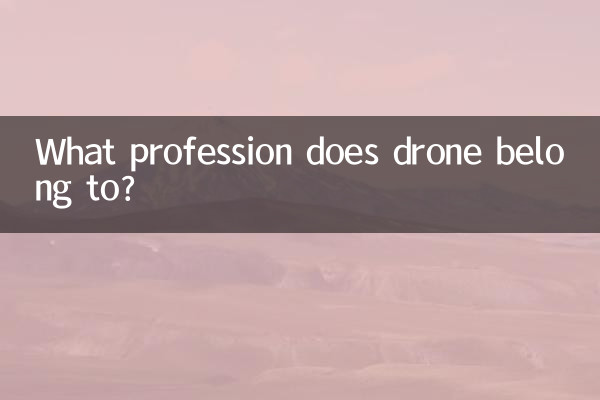What profession does drone belong to? Comprehensive analysis of drone-related disciplines and employment directions
In recent years, drone technology has developed rapidly and is widely used in aerial photography, agriculture, logistics, surveying, security and other fields. Many students and practitioners are interested in the disciplinary affiliation of drones. This article will combine the hot topics on the Internet in the past 10 days, analyze the professional fields of drones, and provide structured data for reference.
1. Core majors involved in drones

UAV is a multidisciplinary field, mainly involving the following professional directions:
| Professional name | Relevance | core courses | Employment direction |
|---|---|---|---|
| Aerospace Engineering | ★★★★★ | Aircraft design, aerodynamics, automatic control principles | UAV R&D and flight testing |
| Electronic information engineering | ★★★★☆ | Circuit design, signal processing, embedded systems | Flight control system development |
| Computer Science and Technology | ★★★★☆ | Artificial intelligence, machine learning, computer vision | UAV intelligent algorithm development |
| Mechanical Engineering | ★★★☆☆ | Mechanical design, mechanics of materials, manufacturing technology | UAV structural design |
| Surveying and mapping engineering | ★★★☆☆ | Remote sensing technology, geographic information system | UAV surveying and mapping applications |
2. Recent hot topics related to drones
According to network-wide data monitoring, hot topics in the field of drones in the past 10 days include:
| topic | heat index | Main discussion platform |
|---|---|---|
| Breakthrough in the application of drones in express logistics | 92.5 | Weibo, Zhihu, industry forums |
| Interpretation of new civil drone management regulations | 88.3 | Government official website, news client |
| Artificial intelligence empowers drones to fly autonomously | 85.7 | Technology media, academic platform |
| Ranking and selection of drone professional colleges | 82.1 | Educational websites, campus forums |
| Cost-effectiveness comparison of consumer drones | 78.6 | E-commerce platform, evaluation website |
3. Recommendations for UAV-related professional colleges and universities
The main colleges and universities in China offering UAV-related majors are as follows:
| School name | Professional name | Featured directions | Establishment time |
|---|---|---|---|
| Beijing University of Aeronautics and Astronautics | Aircraft Design and Engineering | UAV system design | 1952 |
| Nanjing University of Aeronautics and Astronautics | Unmanned Aerial Vehicle Systems Engineering | Military drone technology | 2018 |
| Northwestern Polytechnical University | Aerospace Engineering | Drone control technology | 1938 |
| Harbin Institute of Technology | Intelligent unmanned system | Artificial Intelligence + Drone | 2020 |
| University of Electronic Science and Technology of China | Electronic information engineering | UAV communication system | 1956 |
4. Analysis of employment prospects in the drone industry
The drone industry is in a period of rapid development and has broad employment prospects. According to the latest statistics, the main job requirements are as follows:
| Job category | Average salary (annual salary) | demand growth rate | Main skill requirements |
|---|---|---|---|
| Drone flight control engineer | 180,000-350,000 | 45% | C/C++, control algorithm, embedded development |
| Drone structure designer | 150,000-300,000 | 32% | CAD, finite element analysis, materials science |
| Drone application engineer | 120,000-250,000 | 65% | Industry knowledge, flight operations, data processing |
| Drone algorithm engineer | 250,000-500,000 | 58% | Machine learning, computer vision, path planning |
| Drone flight instructor | 100,000-200,000 | 75% | Flying experience, teaching ability, license |
5. Suggested paths for learning drones
For learners who want to enter the field of drones, it is recommended to follow the following path planning:
1.basic stage:Learn the basics of mathematics and physics, and master the principles of mechanical drawing and circuits
2.professional stage: Choose a specific direction for in-depth study, such as flight control systems, structural design or industry applications
3.practice stage: Participate in drone-related projects and obtain professional qualification certificates such as AOPA or UTC
4.Advanced stage:Learn cutting-edge technologies such as artificial intelligence and big data to improve competitiveness
As an emerging interdisciplinary field, drones include both traditional engineering knowledge and the latest technological developments. Choosing a drone-related major requires not only a solid theoretical foundation, but also the ability to continuously learn new technologies. With the continuous expansion of application scenarios, drone professionals will usher in a broader space for development.

check the details

check the details